,
The year 2009 marks Tapissary’s 32nd anniversary. To celebrate, I’ve been making adjustments to the grammar. The journal is my practice sheet where I merge linguistic invention with my daily experiences. Formulas such as [< >] +/\ are indications of my cyclic grammar.
L'année 2009 correspond au 32ème anniversaire de ma langue inventée de Tapissary. Pour le fêter, mon cadeau c'est le plaisir d'expérimenter avec des rajustements de la grammaire. Ici, dans les pages du journal, je fonds l'invention linguistique avec mes expériences quotidiennes. Mes formules telles que [< >] +/\, sont les indicateurs de la grammaire des cycles.
.
.
tapissed entries
,
12 29 2008
"HAPPY NEW YEAR !"

I reached my goal of posting the basic online dictionary before the end of 2008. Cutting it close by two days! There are 964 common words listed. Click HERE to visit the dictionary.
The phrase above means Have a happy new year, 2009. If you read it literally, word by word, it follows:
May your title hold this happy new year 2009.
...
11 29 2008
"Dictionary project"
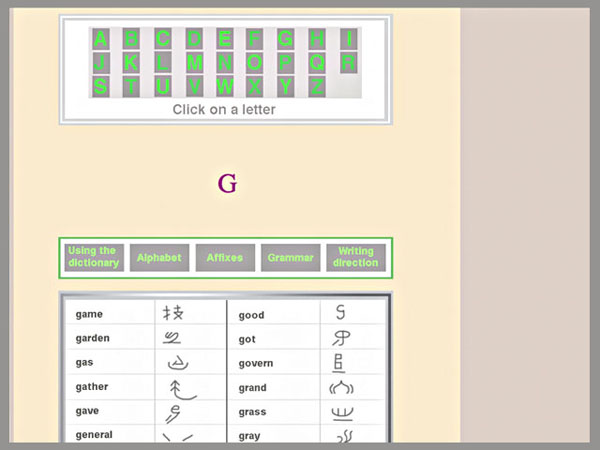
For any visitors wanting to construct their own Tapissed texts, a dictionary of about 1,000 words will soon be available on this site. (This is a dictionary of only the 1,000 most common glyphs, out of Tapissary's total 8,000 glyphs). I derived the list of the 1,000 most common English vocabulary words from About dot com, then made a few changes to that list before translating it into Tapissary. As I finish pages, I post them onto the dictionary section. So far I am up to the letter J. I kept the strokes as clean as possible, but I used a mouse to draw the vocabulary glyphs, and it shows. The 1,000 common words provided will cover some good territory, and the rest of the vocabulary you need can be filled in with the alphabet, which is posted on the dictionary pages. Buttons for grammar will also be visible on each page. I've set up clear links to facilitate navigation. Click here for the dictionary.
...
11 22 2008
"The Alisbet of Tapissary"
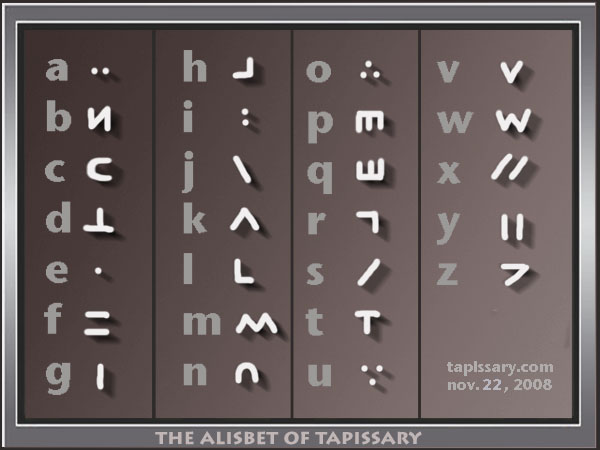
About the alisbet:
Begun on Nov. 20, it took me two days to get the alphabet to where I wanted it. The alisbet is based loosely on the abjad function of Hebrew. However, as to the shape of the letters, the alphabet is derived primarily from the Latin alphabet. Alis- refers to Alice in Wonderland, a version of the story I'm currently writing in my conlang Tapissary. Tapissary is a hieroglyphic language with a syllabary support. I decided to replace the complex syllabary with an alphabet to make things more accessible for my readers. The alisbet may accompany my glyphs and grammatical markers in Tapissary, or stand on their own as a purely alphabetic code of English.
Because I only recently started working with the Alisbet two days ago, time and practice may yield some transformation in the future. For now, I'm posting what I have. The system is loosely based on Hebrew, but is read left to right, as in English. All the vowels are dots. I'm finding that if I ignore the vowels while reading, the consonantal structure makes reading a new alphabet rather easy.
Here is a short text. The transliteration is provided since Tapissary's cyclic grammar renders an altered version.
(Article 1 of the Universal Declaration of Human Rights)
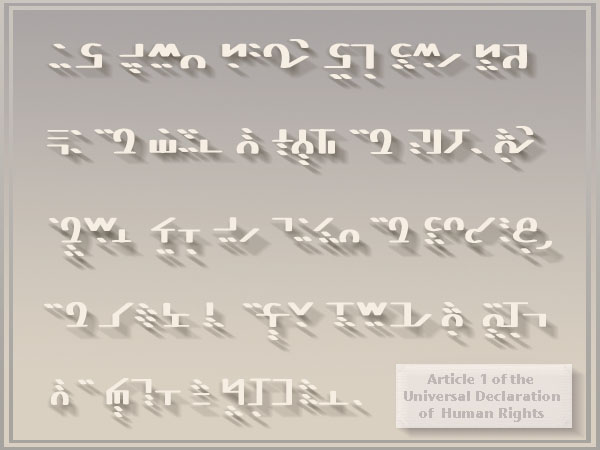
ENGLISH:
∆ All human beings are born free and equal in dignity and rights. ∆ They are endowed with reason and conscience and /\ should act towards one another in a spirit of brotherhood.
TRANSLITERATION:
Each human being's charge comes born free and equal in dignity and rights. One's endowed state has reason and conscience, and should go active towards one another in a spirit of brotherhood.
Spelling Rules:
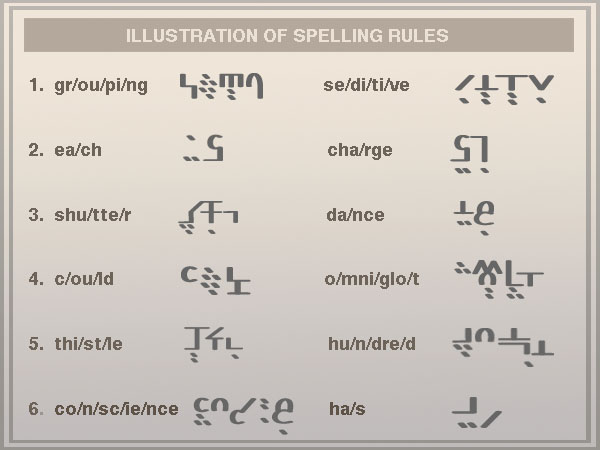
SPELLING RULES
1. Letters are grouped in vertical pairs, such as gr/ou/pi/ng, se/di/ti/ve.
2. The alisbet grafts consonant pairs together. Notice how the CH in 'each' and 'charge' look like a single letter. The C is at the top, the H braces it from below. The RG looks deceptively like an R at first, but its length takes the whole vertical space of a pair and therefore signals that the R is on top, and the G is added below it.
3. If a vowel comes after the pair, it is attached onto the bottom of the pair yielding a vertical column with three letters: shu/tte/r, da/nce. A consonant is never placed at the bottom of a three letter column.
4. Consonant and/or vowel clusters of two or more letters bond together. Therefore, in a word such as 'could', the ou and the ld are paired off: c/ou/ld. Another example binds the consonants in o/mni/glo/t.
5. If a cluster has 3 or more letters, the divisions are chosen by 1) common values (ex: thistle > thi/st/le, where st is more common than tl, so that you would not write it th/is/tle). 2) Separation by way of syllables: hu/n/dre/d.
6. Finals and Medials. When a consonant or vowel is unpaired in the middle or beginning of the word, as you've seen in hu/N/dre/d or in co/N/sc/ie/nce, that letter is kept in the upper position of the vertical column. If the singled out vowel or consonant comes at the end of a word, also seen in the example of hu/n/dre/D or ha/S, it drops to the base level of the vertical column.
...
11 07 2008
"Tapissary 101"
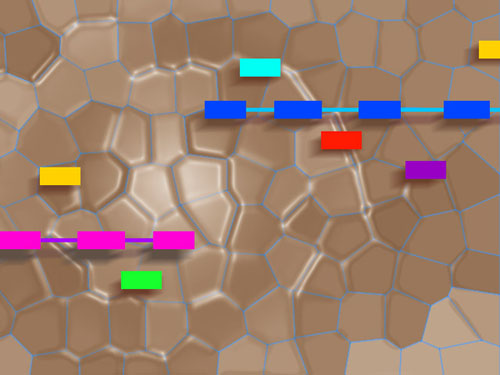
...
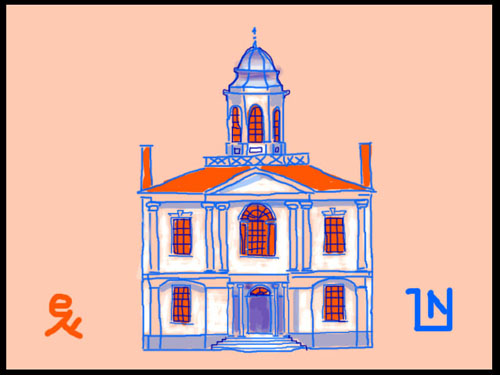
Over two weeks ago, I began a new film about Tapissary. The movie opens with a few facts about its history, followed by examples of how the language works. I'm drawing colorful segments to accompany the soundtrack. The cells above are 2 examples. My goal is to complete and upload the movie onto this site within 3 weeks.
...
10 15 2008
Frontline: "The Choice 2008"

For the past eight years, the 'United States of America' has existed as a figure head, or slogan. The U.S.B. (United States of Bush) may be the more apt acronym for the nation. The will, health of the people, and their environments have always been secondary to Bush. His primary agendas are confined to his personal perspectives. It's certainly time for an evolution of administration.
The Frontline program titled "The Choice 2008", aired on PBS yesterday night. It presents a good summary of the two presidential candidates. McCain and Obama's political views are examined in reference to their fascinating and exceptional histories.
Frontline put the stories in perspective with an unbiased narrative. I learned more about both men. As a result, my respect for both candidates has increased. It's hard to say which man is more likeable. Fortunately, casting a vote is based on the issues rather than personalities. When it comes to those issues, I believe that Obama promises much more potential for our incremented pullout of Iraq - focusing instead on flushing out terrorists, for the environment, and for the economy, among others. McCain, on the other hand, has made a good many errors of judgement lately while trying to court the conservative right without intimidating the moderates. His choice of Governor Sarah Palin is another instance of poor strategy. Obama in the meanwhile, is surrounding himself with highly qualified, intelligent people. His administration may be able to start repairs on the irresponsible and rash damage done by the Bush administration.
This presentation by Frontline isn't meant to sway you one way or the other. It's neutral, and very informative. It covers a good amount of territory in a clear manner. Both Obama and McCain are interesting people to learn about. Please watch the above film.
Since this website is about Tapissary, after all, I'll transliterate the above paragraph into the cyclic grammar. It would sound something like this:
This presentation by Frontline is meant without to sway you one way or the other. It's itself neutral and very informative. It covers a good amount of territory in a clear manner. Both Obama and McCain's charge allow interesting people to learn about. Please your'st eyes the film above.
...
.[][][][][][][][][][][][][][][][][][][][][][][][]
.


